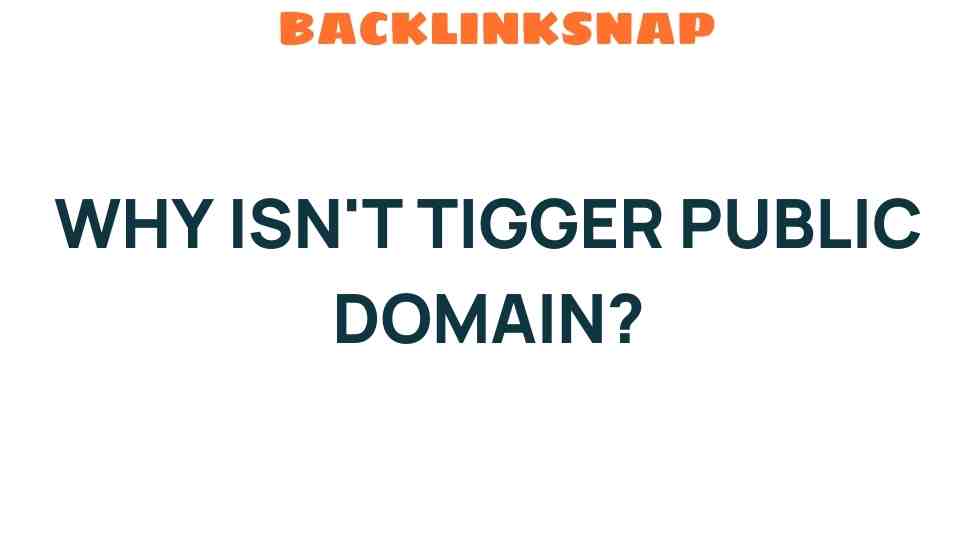Why Isn’t Tigger Public Domain? The Mystery Behind Copyright Longevity
For many, Tigger is a beloved character from the enchanting world created by A.A. Milne, filling our childhoods with joy, laughter, and the thrill of bouncy adventures. Yet, despite his widespread popularity, Tigger remains under copyright protection. This situation raises a fascinating question that transcends mere curiosity: why isn’t Tigger public domain? This article delves into the complexities of copyright laws, the longevity of intellectual property, and the specific circumstances surrounding Tigger and his fellow characters from the Hundred Acre Wood.
The Legacy of A.A. Milne and His Creation
A.A. Milne introduced Tigger in his classic children’s book, “The House at Pooh Corner,” published in 1928. Alongside Winnie the Pooh and other unforgettable characters, Tigger’s personality—marked by boundless energy and a zest for life—quickly captured the hearts of readers. Milne’s legacy is not just in the stories he penned but also in the characters he created, which have become cultural icons.
However, the journey to public domain is a complex one. In many countries, copyright laws protect literary works for a specific duration, often the life of the author plus a number of years. In the case of Milne, who died in 1956, his works are protected until 2026 in many jurisdictions, which is 70 years after his death. This time frame is crucial for understanding why Tigger and his friends have not yet entered the public domain.
Understanding Copyright and Public Domain
Copyright is an essential tool for creators, granting them exclusive rights to their works. This legal framework not only protects the artistic integrity of their creations but also provides economic benefits. The concept of public domain, conversely, refers to works that are no longer protected by copyright, allowing anyone to use them without permission.
When a work enters the public domain, it opens up a world of creative possibilities. Artists, writers, and filmmakers can reinterpret and adapt these characters and stories freely. However, until that moment arrives, copyright holders retain significant control over their intellectual property.
The Role of Disney in Tigger’s Longevity
In exploring why Tigger isn’t public domain, one cannot ignore the significant influence of Disney. The Walt Disney Company acquired the rights to Winnie the Pooh and associated characters in the 1960s, and since then, they have transformed these characters into a multi-billion-dollar franchise. Disney’s adaptations of Milne’s works, including animated films and television series, have further embedded Tigger into the cultural fabric.
Disney’s ownership complicates matters. While Milne’s original texts may eventually enter the public domain, Disney holds the rights to their specific adaptations and representations of Tigger. This means that even when the original character becomes public domain, any distinct portrayal that Disney has created could still be protected under copyright or trademark laws.
Intellectual Property and Character Longevity
The concept of character longevity is integral to understanding Tigger’s status. Characters like Tigger are not merely literary creations; they embody a brand that can be monetized through various media, merchandise, and experiences. Disney’s powerful branding strategy ensures that Tigger continues to thrive in popular culture, thus extending the character’s commercial viability.
- Merchandising: Tigger appears on a wide range of products, from toys to clothing, ensuring that the character remains relevant and profitable.
- Media Appearances: New adaptations and productions keep Tigger in the public eye, reinforcing his connection with audiences old and new.
- Theme Parks: Disney’s theme parks feature Tigger prominently, creating immersive experiences that deepen fan engagement.
Each of these avenues contributes to the character’s longevity, reinforcing the notion that Tigger, as a brand, is still very much alive and commercially viable, which is a critical factor in copyright considerations.
The Future of Tigger and Public Domain
As we look toward 2026, the anticipation around characters like Tigger entering the public domain grows. However, it’s essential to recognize that even after a character enters the public domain, the specific adaptations and trademarks held by companies like Disney will still exert significant influence over how they can be used.
For instance, while someone may be able to write a story featuring the original Tigger from Milne’s texts, they cannot use Disney’s specific animated version without permission. This distinction is vital for creators and consumers alike as they navigate the world of intellectual property.
Conclusion
The question of why Tigger isn’t public domain is multifaceted, rooted in copyright laws, the legacy of A.A. Milne, and the significant role that Disney plays in shaping the character’s present and future. As we await the moment when Milne’s works will enter the public domain, we can appreciate the enduring charm and vitality of Tigger, a character who continues to bounce into our hearts and minds.
FAQs
- When will Tigger enter the public domain?
Tigger is expected to enter the public domain in 2026, seventy years after A.A. Milne’s death. - Can I use Tigger in my own stories after he enters the public domain?
Yes, but you cannot use Disney’s specific version of Tigger without permission. - What is the difference between copyright and trademark?
Copyright protects original works of authorship, while trademarks protect symbols, names, and slogans used to identify goods or services. - Why does Disney hold so much power over Tigger?
Disney owns the rights to adaptations of Milne’s works and has created a highly profitable brand around these characters. - Is Tigger the only character from Milne’s works that is still under copyright?
No, many characters, including Winnie the Pooh, are still under copyright until 2026. - How does public domain benefit creators?
It allows creators to use and adapt works freely, fostering creativity and innovation without the need for permission or licensing fees.
For more information on copyright and public domain, you can visit Cornell Law School. To explore the world of Tigger and friends, check out Disney’s official site here.
This article is in the category Digital Marketing and created by BacklinkSnap Team




